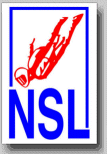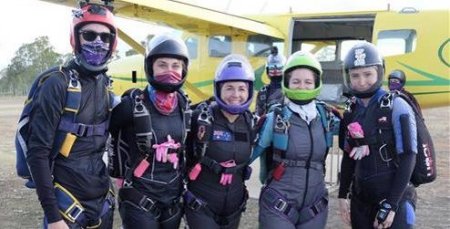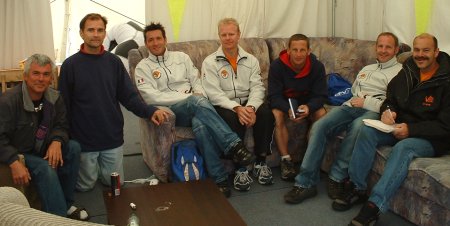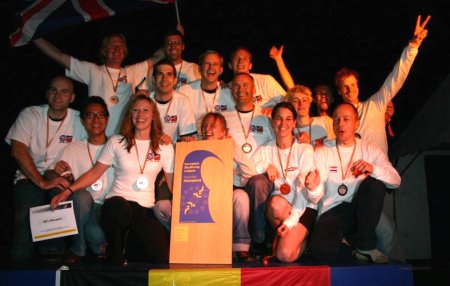
National
Skydiving
League
226 Pecan Street
Deland FL 32724
tel: (386) 801-0804
© 2003 - 2024
All Rights Reserved


226 Pecan Street
Deland FL 32724
tel: (386) 801-0804
© 2003 - 2024
All Rights Reserved


The NSL 4-way category was adopted early by other countries, and the A Class competition was just recently the most popular event of the Virtual Australian Outdoor Nationals 2021, behind the Rookie Class, which has been one of the NSL competition categories since 2002, as well.
The roots of the A Class grew in the early 4-way leagues of the NSL Network, and they were discussed and then defined more carefully when the first league directors decided to add the new categories to the NSL rules. The first affiliated international leagues added their experiences ![]() and feedback to the final set of four competition categories.
and feedback to the final set of four competition categories.
The original purpose of the system was to accommodate the progression of 4-way teams and competitors from the starting point at grass root level to the highly competitive AAA Class with the complete dive pool, and to increase participation on all levels this way. The purpose is still the same today. The NSL News explained the background of the A Class in November 2003.
Florida Skydiving League January 2002 | 1 | 2 | 3 | 4 | 5 | Total | Avg | ||||||
|---|---|---|---|---|---|---|---|---|---|---|---|---|---|
| Rank | A Class | C,G,6 | Q,H,1 | D,2 | P,20 | 15,21 | Total | Avg | |||||
| 1 | Zero Tolerance Miami | 7 | 4 | 4 | 9 | 5 | 29 | 5.8 | |||||
| 2 | Pahokee 4-Play | 7 | 7 | 6 | 6 | -1 | 2 | 28 | 5.6 | ||||
| 3 | 4-Peace | 3 | 2 | 1 | 3 | -2 | 1 | 10 | 2.0 | ||||
| Rank | Rookie | B,C,G | B,Q,H | B,D,E | B,P,L | B,M,A | Total | Avg | |||||
| 1 | Out of Mind | 6 | -3 | 8 | 6 | 7 | 5 | 32 | 6.4 | ||||
| 2 | Windline Thunder | 5 | 1 | 1 | 1 | 4 | 12 | 2.4 | |||||
| 3 | Pointless | 1 | 2 | -2 | 4 | 2 | 2 | 11 | 2.2 | ||||

First, there is the technical part of the actual draw. The AA and A Class draw derives from the AAA Class draw that initiates the weekly NSL competition draw. For the AA Class draw, the memory or mirror-image blocks (“slot-switchers”) are then replaced by other blocks of the AA Class dive pool in the order of the draw.
The next step is similar for the A Class draw. Any of the eight blocks of the AA Class draw are replaced by blocks of the A Class dive pool that have not been used at this point.
This system creates the very interesting aspect that many times the draw is identical between AAA and AA, or AA and A sequences. Teams and competitors like to compare their scores to the upper/lower classes (similar to Open - Advanced Class in the USPA system). However, a pure random sequence in the A Class is only possible if the AAA Class draw creates a sequence beginning with three Random Formations.
ESL Championship 2005 | 1 | 2 | 3 | 4 | 5 | 6 | 7 | 8 | 9 | 10 | Total | Avg | ||
|---|---|---|---|---|---|---|---|---|---|---|---|---|---|---|
| Rank | A Class | 21,F | B,O,H | P,C,L | 6,4 | 7,D | Q,8 | N,9 | 19,A | G,2 | M,K,J | Total | Avg | |
| 1 | Helix | UK | 13 | 23 | 17 | 10 | 13 | 10 | 17 | 10 | 11 | 19 | 143 | 14.3 |
| 2 | Damn Zebra | UK | 12 | 20 | 12 | 9 | 12 | 9 | 13 | 10 | 11 | 16 | 124 | 12.4 |
| 3 | Evolution | UK | 13 | 23 | 12 | 9 | 10 | 9 | 11 | 10 | 9 | 12 | 118 | 11.8 |
| 4 | ASAP PCV Schaffen | BE | 10 | 16 | 10 | 6 | 10 | 7 | 11 | 7 | 8 | 10 | 95 | 9.5 |
| 5 | Groupo Sportivo | CH | 8 | 13 | 7 | 5 | 10 | 5 | 11 | 7 | 8 | 14 | 88 | 8.8 |
| 6 | Spa SWB | BE | 8 | 13 | 7 | 7 | 10 | 6 | 8 | 8 | 6 | 12 | 85 | 8.5 |
| 7 | Daltons | NL | 9 | 11 | 7 | 7 | 6 | 8 | 10 | 9 | 7 | 8 | 82 | 8.2 |
| 8 | Tiramisu | NL | 6 | 12 | 8 | 7 | 4 | 8 | 6 | 7 | 9 | 13 | 80 | 8.0 |
| 9 | Sparadra Spa | BE | 10 | 14 | 7 | 6 | 5 | 6 | 8 | 8 | 2 | 8 | 74 | 7.4 |
| 9 | Go Fast Girls | NL | 10 | 7 | 10 | 6 | 7 | 6 | 8 | 5 | 7 | 8 | 74 | 7.4 |
| 11 | Double Trouble | NL | 10 | 9 | 8 | 7 | 6 | 5 | 6 | 4 | 8 | 8 | 71 | 7.1 |
| 12 | Wings Kassel | DE | 8 | 13 | 3 | 5 | 4 | 1 | 5 | 4 | 5 | 6 | 54 | 5.4 |
| 13 | Black Speed Temploux | BE | 3 | 0 | 3 | 4 | 3 | 3 | 2 | 4 | 6 | 6 | 34 | 3.4 |

The Rookie Class for participants on the grass root level accommodates the first step in the process of learning all necessary skills for skydiving competition. Accordingly, the dive pool includes only random formations.
The A Class introduces the first block techniques, which are a very crucial and the more challenging part of the dive pool. It is true that the draw for this competition class is always block-heavy, which is not only coincidence. It became an accepted side effect of the attempt to synchronize the draw as much as possible. When the creators of the competition classes realized that the A Class draw was block-heavy as a result of the technical synchronization, they gave it some thoughts by considering the bigger picture. And the logic behind the currently applied system became the character of the A Class.
Virtual Australian Outdoor Nationals 2021 | 1 | 2 | 3 | 4 | 5 | 6 | 7 | 8 | 9 | 10 | Total | Avg | |
|---|---|---|---|---|---|---|---|---|---|---|---|---|---|
| Rank | A Class | 19,21 | 9,G | H,6 | P,Q,E | L,D,J | 4,C | A,F,7 | 2,B | K,M,8 | O,N,P | Total | Avg |
| 1 | Bellas | 7 | 7 | 7 | 12 | 9 | 4 | 13 | 2 | 7 | 12 | 80 | 8.0 |
| 2 | Flat Curve | 6 | 7 | 7 | 9 | 8 | 9 | 7 | 7 | 8 | 11 | 79 | 7.9 |
| 3 | Spinny Things | 5 | 9 | 5 | 7 | 8 | 5 | 11 | 8 | 7 | 6 | 71 | 7.1 |
| 4 | The John Denver Experience | 7 | 5 | 4 | 9 | 9 | 3 | 11 | 7 | 7 | 8 | 70 | 7.0 |
| 5 | Airborne Contagion | 6 | 6 | 9 | 7 | 8 | 5 | 9 | 7 | 5 | 7 | 69 | 6.9 |
| 6 | Defence Cunji Slams | 4 | 5 | 6 | 8 | 6 | 7 | 8 | 7 | 7 | 9 | 67 | 6.7 |
| 7 | What's Next | 5 | 7 | 0 | 6 | 4 | 4 | 9 | 6 | 5 | 9 | 55 | 5.5 |
| 8 | Speed Flaps | 4 | 5 | 5 | 4 | 3 | 4 | 9 | 6 | 5 | 7 | 52 | 5.2 |
| 9 | Milly's Mower | 4 | 3 | 6 | 3 | 3 | 6 | 7 | 6 | 5 | 5 | 48 | 4.8 |
| 10 | Contagion Equation | 3 | 2 | 6 | 5 | 2 | 4 | 8 | 7 | 4 | 6 | 47 | 4.7 |
| 11 | The Fomites | 5 | 3 | 4 | 7 | 3 | 2 | 7 | 2 | - | - | 33 | 4.1 |
| 12 | The Wuhan Bats | 1 | 1 | 2 | 0 | 0 | 1 | 1 | 0 | 0 | 1 | 7 | 0.7 |
| 13 | Fat Dumb & Happy | 0 | 0 | 1 | 0 | 0 | 0 | 1 | 2 | - | - | 4 | 0.5 |

 remain current with the block techniques. They use the advantage of meeting coaches, other teams and competitors at the meets to get more technical information. At the end of the season, the A Class teams are quite familiar with these eight blocks and can focus their attention in the following season on the next eight blocks of the AA Class dive pool. It makes the progression from one class to the next one more efficient. A similar thought is behind the step from the AA Class to the AAA Class.
remain current with the block techniques. They use the advantage of meeting coaches, other teams and competitors at the meets to get more technical information. At the end of the season, the A Class teams are quite familiar with these eight blocks and can focus their attention in the following season on the next eight blocks of the AA Class dive pool. It makes the progression from one class to the next one more efficient. A similar thought is behind the step from the AA Class to the AAA Class.
What is the best way to prepare for an A Class draw? Experienced coaches and competitors always emphasize the importance of good random work. And this advice counts for each competition class, not only for the beginners and lower experienced competitors. Even the top competitors still put great emphasis on the random work. Much of this part of 4-way training can now be done in the wind tunnel with great results. It is a fact that teams have to master the blocks to be competitive. A poor block technique can stop the whole dive flow and the success of a skydive, while a poor individual random move might have a smaller effect on the result. On the other hand, great random work puts great scores on the board - if all the blocks have been mastered. Teams and coaches have to find the right balance for the training plan, which can be different for each team.
Going back to the bigger picture of the NSL competition classes, the A Class is a crucial stepping stone on the way to become familiar with the complete dive pool. However, the nature of the A Class sequences should still not ![]() encourage teams to focus their training only on this set of eight blocks.
encourage teams to focus their training only on this set of eight blocks.
Last and not least, all teams eventually use the same draw in the actual competition, which puts the results always in the right proportions. The A Class teams will perform ten rounds at the NSL Playoffs and Championships. This year's events are coming up soon.